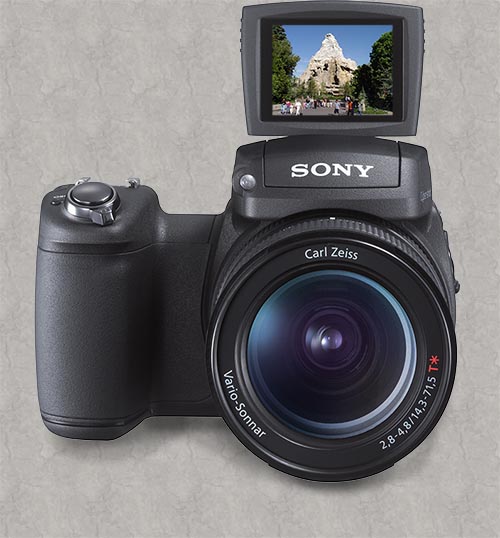
A-DIGITAL-EYE
Camera Review

SONY DCS-R1 DIGITAL CAMERA REVIEW
Unique features
• Lens integral design allows real time preview
• APS-C sized CMOS sensor
• Push button AF in manual focus mode
• Zebra display for highlight warning
• 24-120mm range designed for APS-C sensor size
• Top mounted LCD monitor
• Available framing and preview modes
• Two dial operation: Main Dial and Sub Command dial
• Wide ISO range: 160-3200
• AGCS (Advanced Gradation Control System)
AF and operation response
Under shooting mode, R1 feels very responsive. Startup takes only about 0.7 second. Write speed is fast, however if you shoot in continuous mode, you’ll feel the need for a larger buffer.During playback, the camera feels slower. RAW images can take several seconds to display. 10MP Jpegs take about 1 second.
AF is extremely quiet and very fast in good light. But at telephoto setting the camera can take much longer time to focus. In low light conditions, focusing speed slows down quite a bit.
Shutter lag (from half press to fully press) is short, though doesn’t feel as instant as a DSLR.
Image quality
Image quality of R1 is extremely high. At low ISO’s, R1 is able to capture lots of detail. Sharpness and color are excellent. The default sharpening is not very high, which is good because most buyers would prefer sharpen in post processing. Color balance seems just right, neither too saturated nor too dull.As expected from an APS-C sized CMOS sensor, noise is non-existent at ISO 400 and below. Only little amount of noise is apparent at ISO 800, not bad at all. ISO 1600 starts to show fair amount of noise, especially in very dark areas. ISO 3200 images show significant amount of noise, but they are still very usable when resized.
Like most digital cameras, AWB is extremely accurate under natural light conditions. However it performs poorly under indoor and mixed lighting.
Very little amount of lens distortion exhibited in the real world R1 images (at both ends of the zoom). I had no issues with flare, even when directly shooting into the light source. Chromatic aberration is extremely low, which again goes to show the quality of the optics.
Very little difference is observed between the shots taken with AGCS (Advanced Gradation Control System) and the ones taken without. For most comparisons, I can only observe the difference from the histogram: the ones taken with AGCS have fewer pixels at either extremes of histogram. But the shift is very slight and almost negligible.
Lens extended outSummary
Positives:
- Lens integral design; no dust issue
- Very useful 24-120mm zoom range
- APS-C sized 10.3 MP CMOS sensor captures lots of details with low noise
- Quality optics, little distortion
- Smooth zoom and manual focus feel
- Wide ISO range: 160-3200, very low noise at ISO 800
- Extremely quiet and fast AF in good light
- Live preview with real time histogram
- Quick access to most commonly used controls without going through menu; extremely easy operation
- Almost instant power on, about 0.7 second
- ISO always displayed in viewfinder/LCD
- RGB histogram in playback
- Swivel 2-inch LCD, sharp and detailed (although narrow viewing angle)
- 2 dials operation (dedicated Sub Command Dial for exposure compensation)
- Push button AF in manual focus mode
- Zebra display for highlight warming
- “Framing” view and “preview” view options
- Auto switch between LCD and viewfinder
- Innovative styling
Negatives:
Conclusion
R1 is the first digital camera to offer an APS-C sized sensor combined with a lens-integral design. It offers an impressive feature set at a competitive price (after you factor in the cost of a decent lens for a DSLR). Impressive not only on paper, but the images it delivers. They are detailed and nicely saturated with very little noise capable of very large enlargements. Combined with easy operation, it becomes the perfect camera for a variety of situations. But R1 is clearly not for everyone. For those seeking more flexibility (like shooting action and sports), you’d be better looking at DSLR’s. There are drawbacks for each type of cameras; but for the things R1 is designed for, it does them very well.
